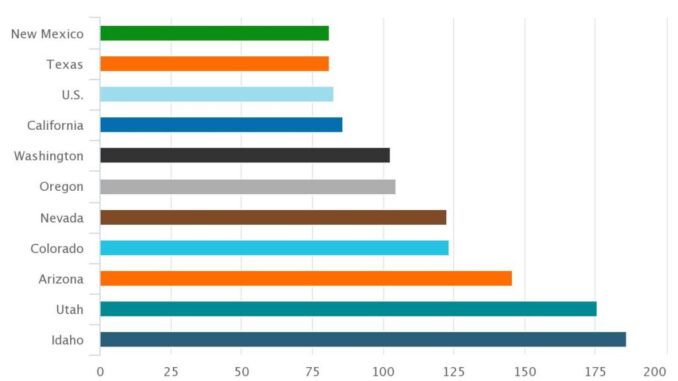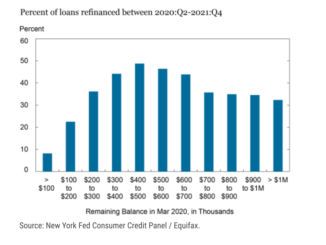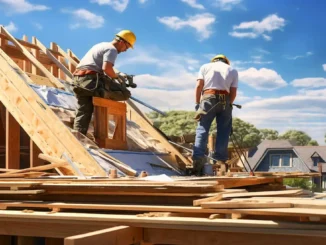
Is this a glimpse of the future in the Southwest? Arizona state officials announced last week that there is not enough groundwater for all of the construction that has already been approved in the Phoenix area. The state paused approving new housing subdivisions in the Phoenix area that would have relied solely on groundwater, which is likely to limit expansion in fast-growing (and, relatively speaking, affordable) areas outside of Phoenix.
There’s a lot of misinformation and general confusion on the subject, so let’s assess what this policy change means for real estate.
The backstory: A report last week from the Arizona Department of Water Resources (ADWR) showed that the Phoenix area projected a 4% shortfall in meeting groundwater demand – roughly 4.9 million acre-feet – over the next 100 years. Concurrently, the Colorado River is also in the midst of one of the worst droughts seen in over 1,200 years, and Arizona, California and Nevada agreed last week to collectively conserve 3 million acre-feet of river water through 2026. Arizona alone agreed to forgo 1.8 million acre-feet – a 55% reduction.
It’s important to note that as of 2020, 41% of Arizona’s water supply came from groundwater, 36% from the Colorado River, 18% from in-state rivers, and 5% was reclaimed water. It’s just as important to note that the biggest user of groundwater isn’t Arizona residents, it’s agriculture businesses, especially alfalfa farming.
According to state estimates, 325,000 gallons is enough for three average-size homes in Phoenix for a year while wells for farming are capable of pumping 3,000 gallons of groundwater per minute. Server farms for technology companies also suck far more groundwater than individual residents.
Regardless, the state has determined there is not enough groundwater to support the rapid growth in the Phoenix metro, at least as it is currently managed and allocated. And it’s the homebuilders who are going to go thirsty – eventually. The policy won’t affect 100-year certificates for 80,000 homes in the Phoenix area that have already been approved, Gov. Katie Hobbs said.
The Phoenix metro is among the six active management areas where new subdivisions must prove to the ADWR that they have a 100-year supply of water. If they don’t, permits will only be issued for new housing if they have alternate water sources. The policy will primarily affect high-growth areas in the Valley of the Sun like Queen Creek, Buckeye, and other nearby communities where homebuilding has boomed in recent years. But limiting land supply typically means home and land values shoot up.
“Housing affordability will be a challenge moving forward,” Spencer Kamps, a lobbyist for the Home Builders Association of Central Arizona, told the New York Times. The HBACA noted that development of industrial and commercial buildings can continue, but homebuilders are restricted unless they find alternate water sources.
What’s happening around Phoenix isn’t new – a similar groundwater restriction was instituted in Pinal County in 2021. The ruling had no effect on the ability of local towns and cities to grow in the near term. Pinal County Supervisor Steve Miller said in 2021 that Casa Grande, a city in Pinal County, had around 25,000 lots that already had an ADWR certificate. The nearby city of Maricopa also has enough water resources to at least double in size over the next few decades.
“I don’t want everybody to panic,” Miller said. “If you have a house in Casa Grande today, you will not run out of water. If you are building a house today you will be fine. We are working on solutions for water issues that will come into play decades down the road, not tomorrow.”
The story is much the same in the Phoenix metro, which saw active home inventory fall 9.8% in May, the biggest drop of any housing market in America. While it’s true that some areas are going to be restricted to homebuilders, there’s a lot of land in the Phoenix area that does meet the 100-year groundwater supply guidelines. Growth will continue, at least in the near- and medium term. Phoenix is also rare among cities in that it’s quite efficient in approving new housing, a rarity among cities in America.
There’s an uncomfortable, existential question that must be asked: have we reached the point where unchecked population growth collides into ecological reality? Should states in the desert stop building homes that depend on water from elsewhere? I would argue that the desert states should ban water-intensive farming methods before restricting homebuilding when we already have a massive housing shortage in this country. But the reality of dwindling water supplies also can’t perpetually be a problem for the next generation to solve.
This obviously isn’t just an issue for Arizonans, either. Look at that chart above! In Utah, which has also seen explosive growth, a legislative committee has proposed building a pipeline from the Pacific Ocean to refill the Great Salt Lake, which hit record-low water levels in November. You’ll often hear of other ambitious, pie-in-the-sky ideas floated, such as $5 billion desalination plant efforts, or water piped in from the Mississippi River. I’m waiting for someone to propose transporting water from Mars.
There simply are no good answers here. I think the era of relatively cheap houses in desert areas will soon be too expensive for public infrastructure to support (unless we make major changes to the way we live, which rarely happens in this country anymore). In the Southwest, this is only the beginning.
What impact do you think this will have on the Phoenix real estate market, which, according to CoreLogic data, is still “overvalued” despite home prices being down 3.7% year-over-year as of April? Should states or towns restrict development? Share your thoughts with me at james@hwmedia.com.
In our weekly DataDigest newsletter, HW Media Managing Editor James Kleimann breaks down the biggest stories in housing through a data lens. Sign up here! Have a subject in mind? Email him at james@hwmedia.com.



